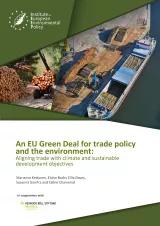An EU Green Deal for trade policy and the environment
The EU is the world's largest trading bloc. It provides the biggest export market for around 80 countries; and EU Member States account for 16% of world imports and exports. Consequently, the EU has a considerable impact on third countries through trade, including the way in which international trade is conducted and how environmental and wider sustainability related aspects are addressed.
The EU sees trade as a key vehicle for supporting developing countries in their efforts to improve their socio-economic status and achieve the 2030 Sustainable Development Goals (SDGs). However, trade also has a flip side: the demand for goods by importing countries – such as the EU Member States – can lead to unsustainable levels and models of production in exporting countries. This translates into the unsustainable use of natural resources, and increased pollution and carbon emissions, further resulting in environmental and ecosystem degradation with various risks to human health and broader wellbeing. There are also issues linked with the sustainability of exports from the EU, for example the export of low-quality waste for recycling to third countries.
Most recently, environmental alarm bells have been triggered by the trade deal between the EU and the MERCOSUR countries (Brazil, Argentina, Uruguay and Paraguay) agreed in June 2019. While the EU-MERCOSUR agreement includes several commitments related to sustainable development – including commitments to comply with the Paris climate agreement and to prevent deforestation – an increasing number of experts and other civil society voices have been pointing out that the agreement lacks effective enforcement measures for these safeguard provisions.
A review of the existing evidence of the EU trade regime reveals that there is indeed cause for concern. While EU trade policy puts a great emphasis on trade being a vehicle for sustainable development, the existing evidence demonstrates that a net positive contribution of the EU trade to sustainable development – going beyond the economic and addressing also the environmental and social aspects – is as yet far from being achieved. Therefore, there is an urgent need to find ways to make EU trade and its impacts on global value chains more sustainable.
The blueprint for EU policy- and decision- making for the coming five years – the European Green Deal by the European Commission – was published in December 2019. The Deal reaffirms EU commitments to sustainability in the context of its trade policy, with a promise to continue strengthening the mainstreaming of social and environmental sustainability concerns in EU trade agreements.
Building on the review of the existing level of environmental integration in the EU trade policy regime, this policy paper explores what a truly green EU trade policy under the EU Green Deal should look like. It makes a number of recommendations for the future five-year policy trajectory, ranging from better use of the impact assessments underpinning the EU trade agreements, to key improvements in the agreements’ sustainability related provisions, including their more assertive implementation. It also highlights the role that the EU’s sector-specific policy initiatives, i.e. initiatives with that have trade related implications but are not directly related to trade agreement negotiations, can have in elevating environmental standards through trade.
Product details
Table of contents
EXECUTIVE SUMMARY 4
1 Introduction 6
2 EU trade policy and the environment 9
2.1 Sustainability Impact Assessments (SIAs) 10
2.2 Trade and Sustainable Development (TSD) Chapters 11
2.3 Environmental provisions of EU FTAs in the context of the global trade policy 15
3 Effectiveness of EU trade policy environmental measures 19
3.1 Effectiveness of EU FTAs’ sustainable development provisions 19
3.2 Strength of the underpinning sustainability assessments 21
4 The transformative power of EU’s sector-specific policies 23
5 Conclusion and recommendations: towards a better environmental integration and standards in trade 26
5.1 Trade under the European Green Deal 26
5.2 International trade regime and the environment 27
5.3 Policy recommendations 29
CASE STUDIES 32
6 Improving the standards of timber trade through the EU Timber Regulation 32
6.1 Introduction 32
6.2 How does the EU Timber Regulation work? 33
6.3 Key lessons learned EUTR strengths and weaknesses 35
6.4 Conclusions 37
7 Improving the standards of trade in minerals through the EU Conflict Minerals Regulation 39
7.1 Introduction 39
7.2 How does the EU Conflict Minerals Regulation work? 39
7.3 Learning from the U.S. Mineral Regulation 41
7.4 Potential strengths and weaknesses 42
7.5 Conclusions 43
8 Improving the standards of recyclable waste through the implementation of the EU circular economy policy 44
8.1 Introduction 44
8.2 EU policy framework for circular economy 44
8.3 EU circular economy policy as a driver for global standards 45
8.4 Conclusion and way forward 46
